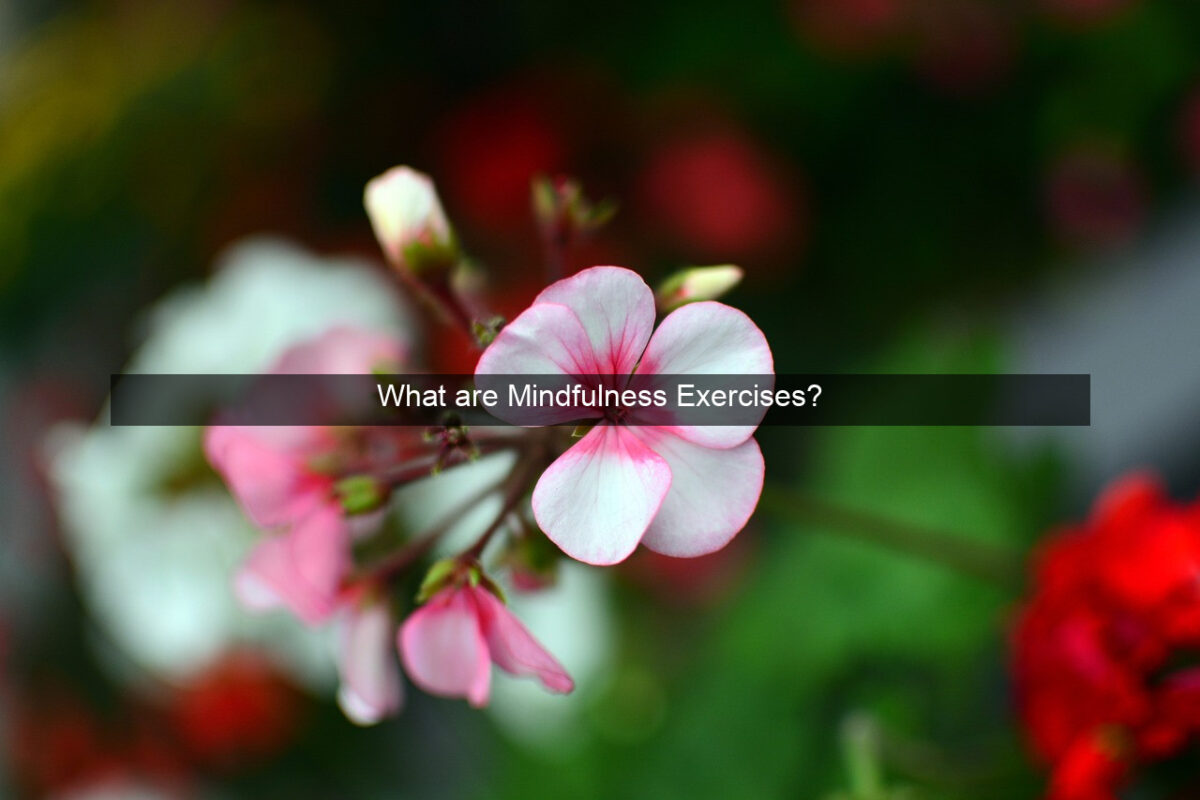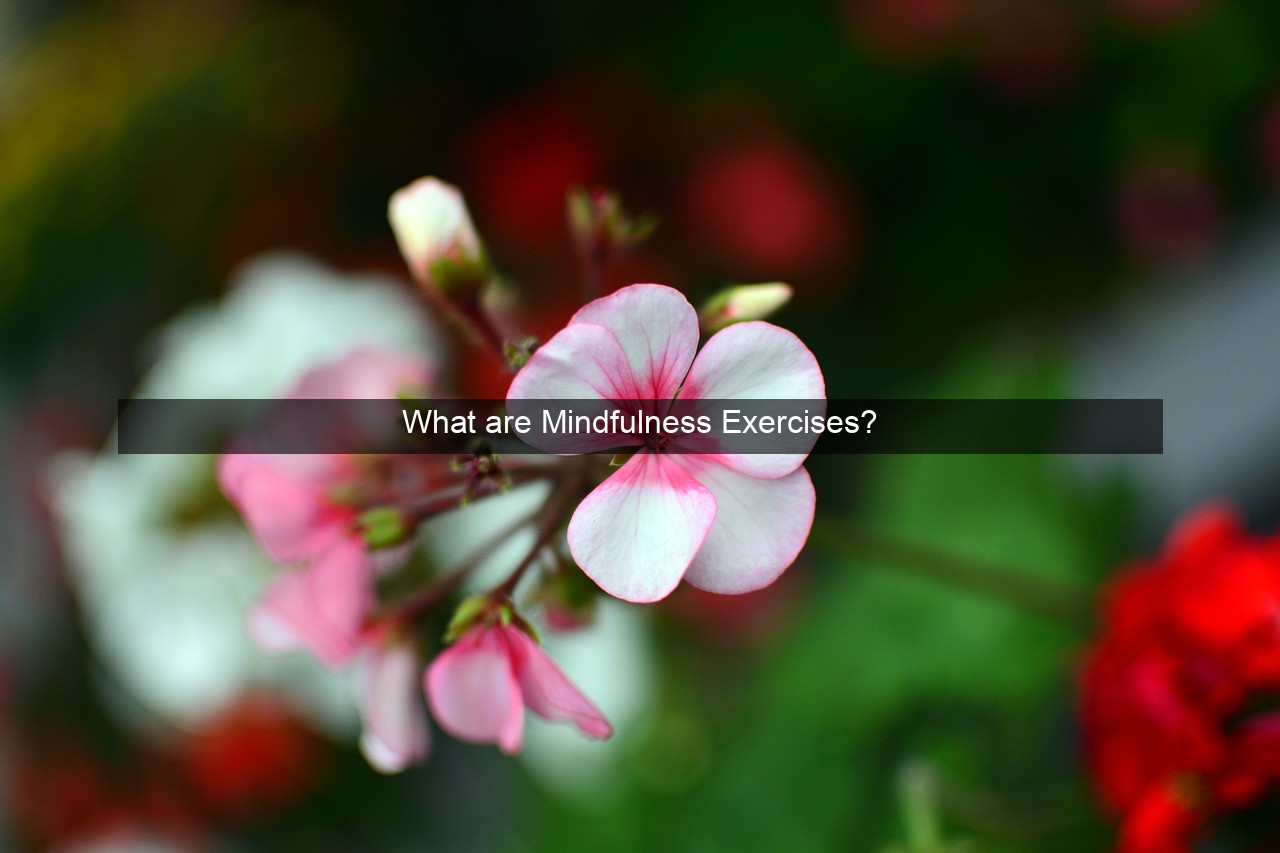What are Mindfulness Exercises?

- What are Mindfulness Exercises?
- What are Mindfulness Exercises?
- Types of Mindfulness Exercises
- Body Scan Meditation
- Mindful Walking
- Mindful Eating
- Benefits of Mindfulness Exercises
- Reduced Stress and Anxiety
- Improved Focus and Concentration
- Increased Self-Awareness
- Incorporating Mindfulness into Daily Life
- Setting Realistic Goals
- Creating a Dedicated Space
- Conclusion

What are Mindfulness Exercises?
In today’s fast-paced world, it’s easy to get caught up in the whirlwind of daily life. We’re constantly bombarded with information, deadlines, and demands, leaving little room for peace and quiet. This constant state of stress can take a toll on our mental and physical well-being. Mindfulness exercises offer a powerful antidote to this modern-day malady, providing tools to cultivate present moment awareness and inner calm. They are simple yet profound practices that can transform how we experience life, helping us to navigate challenges with greater ease and appreciate the beauty of each moment. Whether you’re a seasoned meditator or a complete beginner, incorporating mindfulness exercises into your routine can bring a sense of grounding and clarity to your day.

Types of Mindfulness Exercises
Body Scan Meditation
The body scan is a foundational mindfulness exercise that involves bringing awareness to different parts of your body, noticing any sensations without judgment. Starting with your toes and moving upwards, you simply observe the physical experience of each body part. This practice cultivates a deeper connection with your physical self and helps you to identify areas of tension or discomfort. It also enhances your ability to be present in your body, anchoring you to the present moment.
This exercise can be done lying down or sitting comfortably. The key is to approach it with curiosity and openness, allowing yourself to experience whatever arises without trying to change it. Regular practice of the body scan can improve body awareness, reduce stress, and promote relaxation.
By focusing on the physical sensations in your body, you shift your attention away from racing thoughts and worries, grounding you in the present moment. This can be particularly helpful for managing anxiety and improving sleep quality.
Mindful Walking
Mindful walking is a simple yet effective way to bring mindfulness into your daily life. Instead of rushing from point A to point B, you pay close attention to the physical sensations of walking – the feeling of your feet on the ground, the rhythm of your breath, and the movement of your body. This practice encourages you to be fully present in the moment, appreciating the simple act of walking.
You can practice mindful walking anywhere – outdoors in nature, in your home, or even on your commute. The key is to slow down, focus on your senses, and engage with your surroundings in a non-judgmental way.
This exercise can be a wonderful way to connect with nature, reduce stress, and improve your focus. It also helps you to appreciate the present moment, rather than constantly thinking about the past or worrying about the future.
Mindful Eating
Mindful eating involves paying full attention to the experience of eating – the taste, texture, smell, and appearance of your food. It encourages you to savor each bite, appreciating the nourishment it provides. This practice can help you to develop a healthier relationship with food, reducing overeating and promoting mindful food choices.
Instead of mindlessly consuming your meals, mindful eating invites you to slow down and engage all your senses. Notice the colors and aromas of your food. Pay attention to the textures and flavors as you chew each bite. This practice can transform your relationship with food, helping you to appreciate the simple act of nourishment.
By cultivating awareness of your hunger and fullness cues, you can make more conscious choices about what and how much you eat. This can be especially helpful for managing weight and improving digestion.
Benefits of Mindfulness Exercises
Reduced Stress and Anxiety
Mindfulness exercises have been shown to effectively reduce stress and anxiety. By focusing on the present moment, you can quiet the constant chatter of the mind and cultivate a sense of calm. This can be particularly helpful for managing daily stressors and navigating challenging situations.
Studies have demonstrated that regular mindfulness practice can lower cortisol levels, the hormone associated with stress. This can lead to a greater sense of well-being and improved emotional regulation.
By training your mind to focus on the present, you can break free from the cycle of worry and rumination that often fuels anxiety.
Improved Focus and Concentration
Regular practice of mindfulness exercises can enhance your ability to focus and concentrate. By training your attention on the present moment, you strengthen your capacity for sustained attention and reduce mental distractions.
Mindfulness helps to cultivate a more focused and attentive mind. This can improve your performance at work, school, and other areas of your life.
By learning to observe your thoughts and emotions without judgment, you can gain greater control over your attention and reduce mental clutter.
Increased Self-Awareness
Mindfulness exercises can foster greater self-awareness by encouraging you to pay attention to your thoughts, emotions, and bodily sensations without judgment. This increased awareness can provide valuable insights into your inner world, helping you to understand your patterns of thinking and behavior.
By becoming more attuned to your inner experience, you can develop a deeper understanding of yourself and your reactions to the world around you.
This increased self-awareness can lead to greater emotional intelligence and improved relationships with yourself and others.
Incorporating Mindfulness into Daily Life
Setting Realistic Goals
Start small and gradually increase the duration of your practice. Consistency is key. Even a few minutes of daily mindfulness can make a difference.
Don’t try to do too much too soon. Begin with short mindfulness exercises and gradually increase the length of your practice as you become more comfortable.
It’s important to be patient with yourself and celebrate your progress along the way.
Creating a Dedicated Space
Find a quiet and comfortable space where you can practice without distractions. This could be a dedicated meditation corner, a quiet room in your home, or even a peaceful spot outdoors.
Having a designated space for your mindfulness practice can help to create a sense of ritual and enhance your focus.
Make sure your space is free from distractions and conducive to relaxation.
| Exercise | Duration | Frequency |
|---|---|---|
| Body Scan | 10-20 minutes | Daily |
| Mindful Walking | 5-15 minutes | Several times a week |
| Mindful Eating | During meals | Daily |
- Body Scan
- Mindful Walking
- Mindful Eating
Conclusion
Mindfulness exercises offer a pathway to greater peace, presence, and well-being. By cultivating present moment awareness, we can learn to navigate the challenges of life with greater ease and appreciate the beauty of each moment. Whether you choose to practice formal meditation, mindful walking, or simply bring greater awareness to your daily activities, incorporating mindfulness into your life can have a profound impact on your overall well-being.
What are the benefits of mindfulness exercises?
Mindfulness exercises can reduce stress and anxiety, improve focus and concentration, and increase self-awareness.
How do I start practicing mindfulness?
Start with short, simple exercises like mindful breathing or body scan meditation. Gradually increase the duration of your practice as you become more comfortable.
How often should I practice mindfulness?
Even a few minutes of daily practice can be beneficial. Consistency is key.
What are some common mindfulness exercises?
Common mindfulness exercises include body scan meditation, mindful walking, mindful eating, and mindful breathing.



